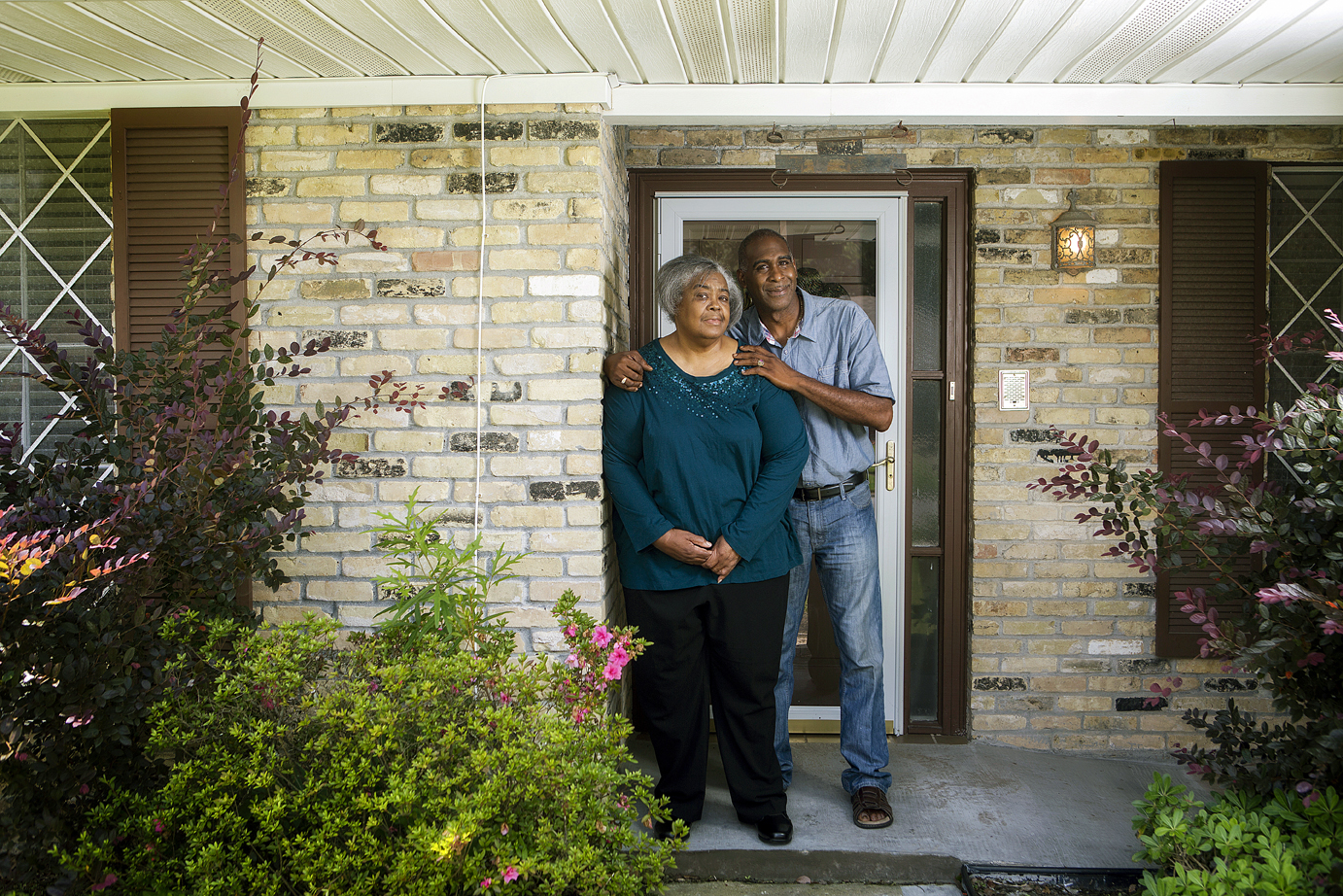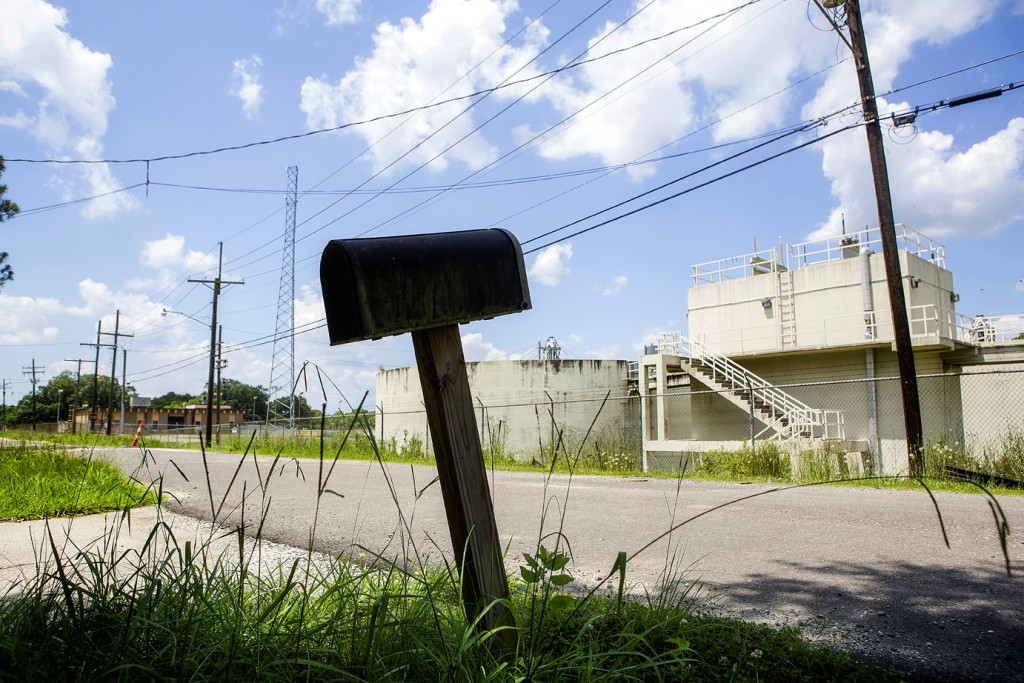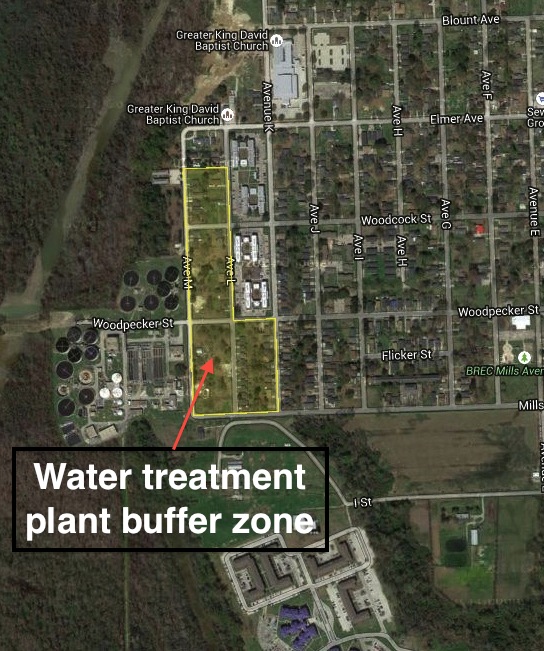
How to move a neighborhood
Mamie Mitchell and her son Greg at her new home in the Park Forest subdivision. Photos by Collin Richie
Residents start building new lives after being relocated away from north BR wastewater treatment facility
Mamie Mitchell moved to University Place in 1972. The north Baton Rouge subdivision, located behind Southern University, was a quiet, family-oriented community then. A place where neighbors looked out for each other. She could watch her two boys play in the park across the street.
She was also right across from a city-parish wastewater treatment facility. During those early years she recalls little more than a single shed and one pump a distance from the homes. But as the city grew, the park was demolished and the plant was expanded until it was practically right at Mitchell’s front door.
“As the plant grew, the problems grew,” says Mitchell’s son Greg, who was a child when the family moved to the neighborhood and later became one of its most vocal advocates.
|
|
Those problems included sewer flies, rats, what Mitchell describes as a “nasty mist,” and a smell that Greg compares to that of a dead, rotting animal. It got to the point where Mitchell’s grandchildren didn’t even want to visit, she says.
It took two decades of fighting, but Mitchell and some of her neighbors finally got the city-parish to move them away from the sewage plant. Several blocks closest to the plant were ultimately cleared out. Mitchell, the last to leave in April, has settled into a comfortable home in the quiet confines of Baton Rouge’s Park Forest subdivision.
But far from victorious, she just sounds resigned.

“You get to the point where you fought for so long, you get tired,” she says. “I should have fought some more.”
The fight began in 1996, when, according to Greg Mitchell, some 200 or so University Place residents sued the parish. The group won at trial, and Mitchell says the judgment was worth about $3 million. That money was not specifically to buy out the residents, but it was meant to compensate them for the suffering and health problems they say were caused by the plant. The judgment was thrown out on appeal, although Greg says his mother got to keep $20,000 to pay for depreciation on her home.
But the Concerned Citizens of University Place, with Greg as their primary spokesman and leader, kept working. Greg says he contacted every government official he could think of, from the Metro Council to members of Congress. He wanted to make sure the council heard from University Place residents, not just city-parish attorneys.
Around 2009 or 2010, the neighborhood group reached out to the Louisiana Environmental Action Network’s Executive Director Marylee Orr. LEAN recently had discovered a dark plume flowing into the Mississippi River from the plant. It contained “fecal coliform too numerous to count.” LEAN filed a complaint with the U.S. Environmental Protection Agency alleging Clean Water Act violations.
The plume meant the plant was in violation of its permit and a consent decree filed with the EPA in 2002, according to Adam Babich of the Tulane Environmental Law Center, which frequently works with LEAN. The decree set pollution limits for the plant while the city-parish worked to improve the system. The penalties might have cost the city-parish millions.
Those alleged violations seemed to bolster the complaints from residents.
“I have no idea what impact that may or may not have had on the Metro Council,” Babich says. “But I think having those claims out there helped the administration decide to negotiate with the residents.”
Babich says the EPA didn’t agree to a “quid pro quo,” meaning the agency didn’t explicitly say it would drop the fines if the city-parish moved the residents, but he doesn’t expect the agency will try to collect the fines. LEAN says its findings were “leveraged to relieve the suffering of the community impacted by the identified pollution.”
Officials from the EPA and the U.S. Department of Justice arrived in Baton Rouge in 2012, according to EPA attorney Suzanne Murray. Orr recalls an EPA official getting emotional while trying to walk through the neighborhood’s sewage mist.
Former EPA head Lisa Jackson’s passion for environmental justice—the fair treatment of low-income and minority neighborhoods that often bear the brunt of pollution—raised Orr’s hopes that the EPA would find a way to help.
“We came upon a tense situation where legal options were scarce,” Murray wrote in a blog post last year. “All we had was a decade-old enforcement consent decree, a civil rights complaint, and no consensus on how to move forward.”
What followed, Murray says, were months of negotiations “at kitchen tables, in conference rooms and community centers and at [Metro] Council meetings.” Those discussions often were tense—at least one nearly came to blows, according to one witness. But the result was a new consent decree among EPA, the city-parish, the citizens’ group and LEAN.
The Metro Council approved a relocation proposal in 2013, and the city-parish bought out 41 residents without a fight. As of June 4, there had been eight amicable vacant land acquisitions, and the parish intended to expropriate 11 more vacant parcels.
The parish also plans to create a “visual and odor buffer” around the plant out of trees and vegetation. So far, almost $5.5 million has been spent to buy property and pay moving costs, and the anticipated total cost of the project is $6.8 million, according to CH2M, the private company that is overseeing the parish’s $1.6 billion sewage system overhaul.
 The Mitchells say residents didn’t get cash for their old homes. They weren’t compensated for their years of suffering or the health problems they say were caused or exacerbated by the plant, either. However, in some cases, non-resident owners are paid a share of the home’s value, says Wilma Subra, a technical advisor to LEAN.
The Mitchells say residents didn’t get cash for their old homes. They weren’t compensated for their years of suffering or the health problems they say were caused or exacerbated by the plant, either. However, in some cases, non-resident owners are paid a share of the home’s value, says Wilma Subra, a technical advisor to LEAN.
The city-parish paid to have each house appraised as if it wasn’t next to a sewage plant, Subra says. In some cases, the appraisers helped residents find comparable houses in other neighborhoods. The area to be bought out was decided via the negotiations, and not everyone who wanted out was able to leave.
 The buyouts aren’t unprecedented in the state. LEAN counts two dozen community buyouts over the past 20 or so years, although typically it’s a private industrial plant owner doing the buying. ExxonMobil has spent years slowly buying up properties across from its refinery along Scenic Highway, creating more than 250 acres of green space where homes once stood. Residents near a south Baton Rouge water treatment plant have had complaints similar to those of University Place for years, but the neighbors have yet to get organized.
The buyouts aren’t unprecedented in the state. LEAN counts two dozen community buyouts over the past 20 or so years, although typically it’s a private industrial plant owner doing the buying. ExxonMobil has spent years slowly buying up properties across from its refinery along Scenic Highway, creating more than 250 acres of green space where homes once stood. Residents near a south Baton Rouge water treatment plant have had complaints similar to those of University Place for years, but the neighbors have yet to get organized.
This may have been, as Orr suggests, the best outcome the University Place residents were likely to get. But while you can exchange a house, you can’t replace a community.
Irma Miller, who fought alongside the Mitchells, also is settled into her new home after the buyout. She likes being able to go outside now, but she misses her neighbors.
“We scattered everywhere,” she says. “I think they owed the neighborhood more. It’s not like we moved into their space.”
|
|
|
